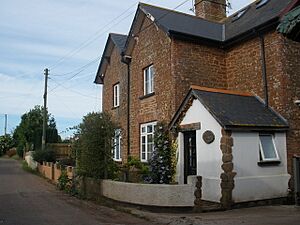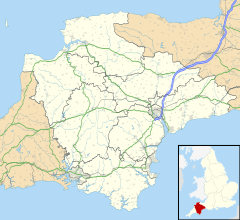Poltimore facts for kids
Quick facts for kids Poltimore |
|
|---|---|
 Hayes Dairy Cottages |
|
| Population | 297 (2011 Census) |
| Civil parish |
|
| District |
|
| Shire county | |
| Region | |
| Country | England |
| Sovereign state | United Kingdom |
| Post town | EXETER |
| Postcode district | EX4 |
| Dialling code | 01392 |
| Police | Devon and Cornwall |
| Fire | Devon and Somerset |
| Ambulance | South Western |
| EU Parliament | South West England |
| UK Parliament |
|
Poltimore is a small village and a civil parish (a local area with its own council) in the East Devon district of Devon, England. It is located about 5 kilometres (3 miles) northeast of the city of Exeter. In 2011, the village and its surrounding area had 297 people living in 122 homes. The nearby small area called Ratsloe is also part of Poltimore parish.
| Top - 0-9 A B C D E F G H I J K L M N O P Q R S T U V W X Y Z |
A Look Back: Poltimore's History
Poltimore has a long and interesting history! It was once a "manor," which means it was a large estate ruled by a lord.
Early Records
When the famous Domesday Book was created in 1086, two manors were recorded in Poltimore. The Domesday Book was a huge survey ordered by William the Conqueror to record who owned what in England.
- The main manor was owned by Haemeric de Arcis, a soldier in William the Conqueror's army.
- A smaller manor, called Cutton, belonged to a group of religious leaders (Canons) from St. Mary at Rouen in France.
What's in a Name?
The name Poltimore likely comes from an old Welsh language phrase, Pwlltymawr. This means "The Pool by the Great House."
- Pwyll means "pool."
- Ty means "house."
- Mawr means "great."
In the 1200s, a family called de Pultymor owned the Manor of Poltimore. They also had a home with a similar name in Glamorgan, South Wales. Over time, the family's name changed to de Poltimore and then simply Poltimore.
The Bampfylde Family and Poltimore House
Poltimore has been the historic home of the Bampfylde family for a very long time.
- Around 1303, the Bampfylde family became important in the area.
- In 1641, Sir John Bampfylde, 1st Baronet was given a special title called a "baronetcy," which was named after the village of Poltimore. A baronet is a title of honour, passed down through families, similar to a knight but hereditary.
- The grand house, Poltimore House, was probably rebuilt by Sir Coplestone Bampfylde, 2nd Baronet. You can even see the date 1681 carved on the stone gate at the house's main entrance!
In 1610, a writer named William Camden wrote a book called Britain. In it, he mentioned Poltimore as the home of the "worshipfull and right antient family of Bampfield," showing how well-known they were.
Population Over Time
The number of people living in Poltimore has changed over the years:
- In 1801, there were 250 people.
- By 1887, the population grew to 288.
- In 1901, it was 298 people.
Getting Around: Transport
The village of Poltimore is located just west of the M5 motorway, which is a major road in England.
St. Mary's Church
Poltimore has one church, called St. Mary's. It's a beautiful old building with some interesting features.
- The church has Renaissance style details in its ceiling (vaulting), which were added around 1520.
- Inside, you can find a tomb with statues of Richard Bampfylde (who died in 1594) and his wife, Elizabeth (who died in 1599). This tomb is in the south transept, which is a part of the church that sticks out, making the building look like a cross.
- The church was carefully restored by an architect named Robert Medley Fulford between 1878 and 1884.
Places Nearby
Poltimore is surrounded by several other interesting villages:
- Brampford Speke
- Broadclyst
- Clyst Honiton
- Newton St Cyres
- Pinhoe
- Stoke Canon
- Upton Pyne


